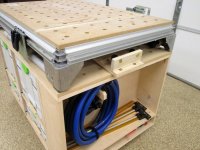There have been several threads discussing the build of a number of very nice looking mobile cart/benches that make use of MFT/3 tables that mount on top of them. While I have no issue with the utility of such benches, and while I like that they are mobile and provide space for systainers, dust collectors, and router tables, my question is why do they use MFT/3 tables. Is it simply to avoid having to build an MFT/3 top? Or is it place to store/use your MFT/3 table while it is in your shop?
Personally, I have two Festool MFT/3 tables. In addition, I have now built several work benches, including three separate ones that use MFT-type tops (20mm holes on 96mm centers), namely, an MFT-C bench, a Ron Paulk type, and a folding bench. For each of the latter three I created the tops using 3/4" MDF along with a method that I described in a prior post that uses a Festool 32mm "holey" rail along with a TSO rail square.
So, what am I missing?
Sandy
Personally, I have two Festool MFT/3 tables. In addition, I have now built several work benches, including three separate ones that use MFT-type tops (20mm holes on 96mm centers), namely, an MFT-C bench, a Ron Paulk type, and a folding bench. For each of the latter three I created the tops using 3/4" MDF along with a method that I described in a prior post that uses a Festool 32mm "holey" rail along with a TSO rail square.
So, what am I missing?
Sandy


